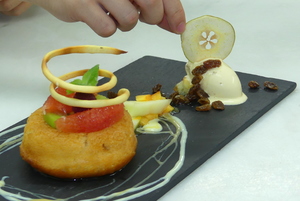Cape gooseberry
Physalis is the genus of those plants that belong to the Solanaceae family. It grows in template, warm and subtropical regions around the world.
This genus is distinguished by its little, orange or yellow fruit, which is similar – in size, shape and structure – to the tomato. However, the cape gooseberry is partly or completely wrapped by a big peel that comes out of the calyx.
It is eaten in its natural form, with chocolate, in patisserie, with jelly, juices, ice creams, sweets, marmalades, with sauces for white meat, in salads and also as decoration for special dishes. It is internationally considered an exotic fruit. Marmalades, nectars, cloudy juices and canned products can be made whit this fruit, with very satisfactory results. Between 83 % and 86% of its pulp can be used.
-
Type of dish
- Beers
- Cocktails
- Breakfasts and brunch
- Burguers
- Juices, milkshakes and beverages
- Shellfish
- Bread and pastries
- Pizzas, patty
- Dessert
- Pasta
- Sándwich
- Pastries
- Finger foods
- Ice creams and sorbets
- Legumes
- Salads
- Eggs
- Patty
- liqueur
- Harvard plate
- Main course
- Meats
- Fish
- Birds
- Vegetables
- Soups and creams
- Rices
- Coffee, chocolate and infusion
- Cheeses
- Appetizers and canapes
- Temperature
- Cuisine type
- Additional culinary preparation
- Conservation technique
- Seasonal recipes
-
- Aromatic herbs
- Beverages
- Big game hunt
- Bread and pastries
- Canned goods and pickles
- Cereals
- Condiments, spices and additives
- Cooked, salted, preserved and cold meats
- Dried fruits and nuts
- Dry pulses
- Edible oils and vinegars
- Eggs and derivatives
- Feathered game hunt
- Fish cuts
- Fishes
- Insects
- Kitchen and bakery tecniques
- Kitchen and bakery utensils
- Meat cuts
- Meats
- Milk, cream and derivatives
- Mushrooms
- Offal
- Pasta, rice, flour and derivatives
- Poultry
- Seafood
- Service techniques
- Service utensils
- Vegetables cuts
- Vegetables, fruits, tubers and seaweed


